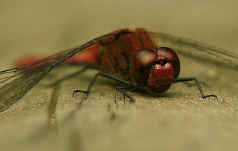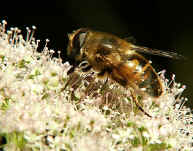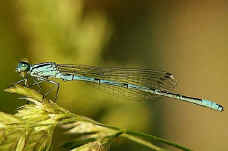Offwell Wetland Survey
Before and After
 |
|
| Before restoration, the wetland area was smothered in tangled Rhododendron and very little else. | Spring in the wetlands, almost ten years after restoration. Looking North from the dam wall. |
The wetland area, prior to restoration, was essentially a dried-up former lake with a stream still running through it (Historical Background). Rhododendron had encroached on the whole area, turning it into a virtually impenetrable jungle. Underneath the Rhododendron, the low light levels meant that there was almost no natural vegetation, except on the East side where a small patch of Yellow Iris persisted. A few tall, thin Silver Birch and Willow trees struggled to reach the light above the Rhododendron canopy. Rhododendron supports no native invertebrates. This, together with the virtual absence of native vegetation under the canopy, meant that the area supported almost no wildlife and had become an essentially sterile zone. Clearance of rhododendron started in 1988. By March
1989 the dam wall had been repaired and The Wetland was flooded.
Wetland Description, Year 2000. Nearly ten years after restoration, the
wetland at Offwell has become an extremely rewarding area in which to stand quietly and
watch wildlife pass by. On a warm, sunny, late summer afternoon, dragonflies such as
Southern Hawkers patrol their territorial boundaries. Ruddy Darter dragonflies survey the
scene from the warm wooden railings along the damn wall. The Offwell wetlands are one of
only two places in Devon where they are known to breed. Their daintier cousins, Blue
damselflies sit on the luxuriant vegetation like glowing sapphire jewels, while a great
variety of different hoverflies investigate the white flowerheads of the Angelica plants
dotted around the wetland. Their busy hum merges with that of weighty bumblebees searching
for nectar. |
 |
 |
 |
Ruddy Darter dragonfly |
Hoverfly |
Blue damselfly |
Roe deer come to lie up during the day in the moist coolness of the wetland or drink at its waters in the early evening. Voles scurry about in the undergrowth, while miniature frogs and toads, this year's new youngsters, blend into their background, camouflaged from the Grass Snake curled up sunning itself nearby. A lucky observer may spot the resident Kingfisher sitting on a stump in the centre of the open water area, contemplating his next meal. Numerous other small birds frequent the adjacent trees, taking advantage of the abundance of invertebrate life inhabiting the wetland. Willows, common in the wetland, can harbour up to 400 different species of invertebrates alone! Add on to this the myriad invertebrates associated with the other wetland plants present and it is easy to see that it must be rather like a Fast Food outlet. All of this takes place against a backdrop of vegetation as diverse as it is lush. The wetland itself is not uniform. It slopes downwards from north to south, so that the southern swamp areas are covered by standing water. This then leads into the open water areas adjacent to the dam. Water exits from the wetland over a spillway on the dam wall. The wetland area is fed by a small stream entering the northern side and winding through marshy areas, finally merging into the south western swamps of the wetland (Diagram). Water levels are therefore also high in this south-western zone. The marshy region in between is partially covered by standing water in places, but this is not uniform. Dips and depressions in the region fill with water, the larger depressions forming small ponds in otherwise uncovered areas. Within the wetland, small local hillocks and bumps of accumulated sediment occur, which provide areas raised above the general level of the wetland. This allows plants normally requiring drier conditions to survive, despite sometimes being in the midst of standing water. For example, Silver Birch saplings and seedlings, as well as Brambles, can be found growing in the middle of the wetland area, when normally they would be confined to the drier areas on the margins. The marsh zones merge into swampy standing water zones and thence into the open water. Zonation in wetlands |
Compare Plant Surveys for 1991 & 2000
